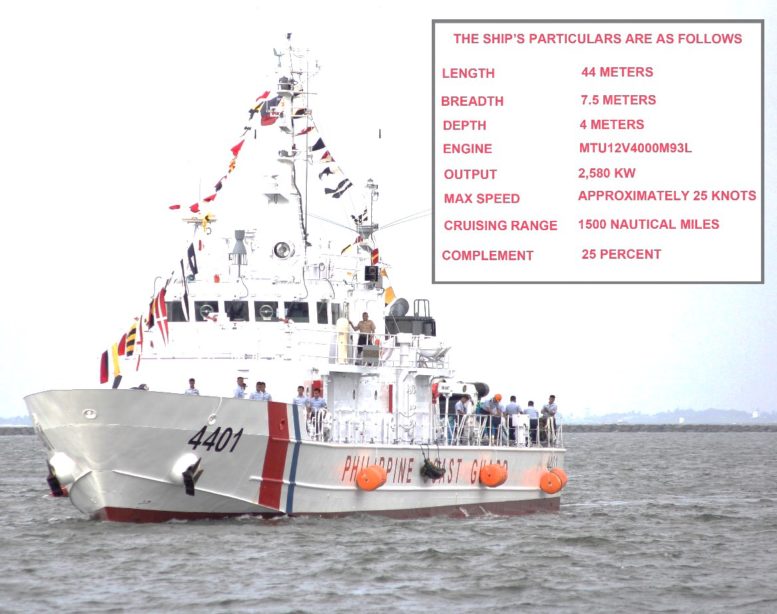The popular slogan of President Duterte –“Change is Coming” — enthralled the Filipino people, as the Philippine Coast Guard (PCG) rode that wave of change. Indeed, change had come and the PCG welcomed this wave that would break the long standing shortage in PCG maritime assets. The PCG started to change within as modernization of its fleet had began with the arrival of the first PCG Multi-Role Response Vessel.
On 18 August 2016, the Japan Government formally handed-over the first multi-role response vessel, BRP Tubbataha (MRRV-4401) to the PCG after her “Arrival and Blessing Ceremony” at the Headquarters Coast Guard Ready Force, Pier 13, South Harbor in Manila.
The construction of the 44-meter vessel started last February 2016 and was completed on July of the same year. She was named after Lighthouse Tubbataha which is located in Tubbataha Marine National Park, Palawan.
Prior to her departure from Japan, a naming ceremony was held which was attended and witnessed by the PCG Commandant RADM WILLIAM M MELAD PCG and Ambassador Manuel M Lopez of the Philippine Embassy to Japan. High-ranking officials from concerned agencies in Japan headed by Vice Admiral Hideyo Hanazumi JCG also graced the event.
She departed Japan on 11 August 2016 with two (2) PCG officers and ten (10) non-officers onboard en route to Naha, Okinawa for bunkering prior to its voyage to the Philippines.
Nine (9) more MRRVs will be built by the Japan Marine United Corporation (JMUC) Yokohama Shipyard for the PCG and will also be named after the primary lighthouses in the country to denote the important role of the lighthouse as crucial aid in navigation to the mariners.
RADM Melad lauded the Japanese government for the continuous and unwavering support to the PCG’s capability development programs. Over the past 18 years, Japan, through the Japan International Cooperation Agency (JICA), has extended numerous assistance to the PCG in terms of human resource development, providing additional equipment for the communications, diving and rescue, personal protective equipment for oil spill combat operations, and donating small boats and rubber boats.
Looking back, BRP Corregidor (AE-891) was the first Coast Guard vessel donated by the Japanese government in 1998. AE-891 is a 56-meter lighthouse/ buoy tender vessel which is one of the capital ships of the PCG primarily used in the installation of buoys and other aids to navigation, and in the removal of obstructions and hazards to the safety of navigation.
The project which built the MRRV, the Maritime Safety Capability Improvement Project, was awarded by the transportation department to the Japan Marine United Corporation (JMU). It is being implemented as an Official Development Assistance (ODA) project, via a tied loan extended by JICA.
Under the project terms, the MRRVs will be used by the PCG for the following purposes:
• Primary rescue vessels within the PCG District’s areas of responsibility (AOR) when the extent of the disaster is beyond the capability of floating assets deployed within the area;
• Assistance in the control of oil pollution and protection of the marine environment;
• Enforcement of all applicable maritime laws within the designated AOR, particularly relating to illegal fishing and sea patrol;
• Service as platform for rapid response during relief operations in the area;
• Transport of personnel and logistical support.
The MRRVs will be deployed into various PCG Districts across the country, including Manila, La Union, and Puerto Princesa. The project includes the7 supply of standard spare parts and tools, crew training, ocean transportation, and marine insurance. The vessels will have a standard cruising speed of 25 knots, and a range of 1,500 nautical miles.
The delivery of the second MRRV is expected to take place sometime in December 2016. The remaining eight (8) vessels will be delivered on a staggered mode in 2017 until the 2nd quarter of 2018.
PCG Gears Up with its First Brand New MRRV from Japan
